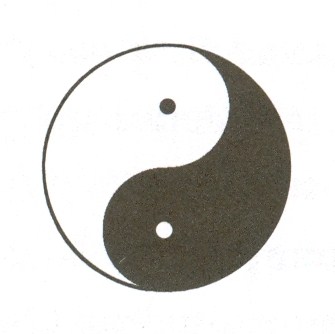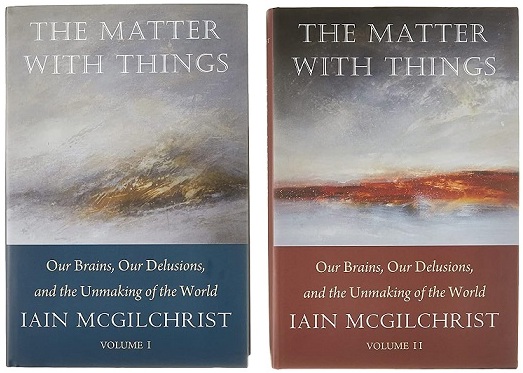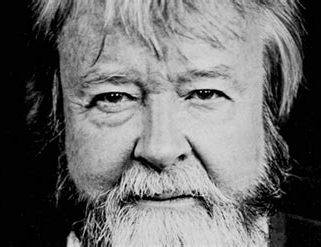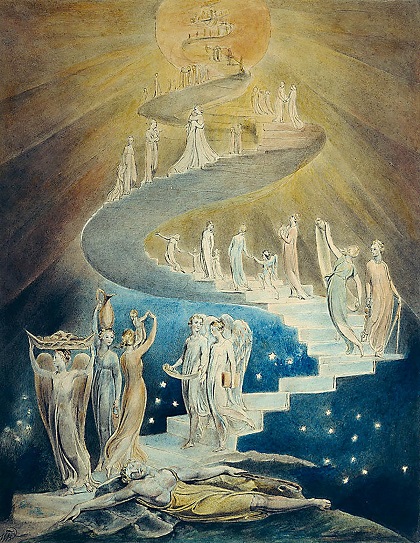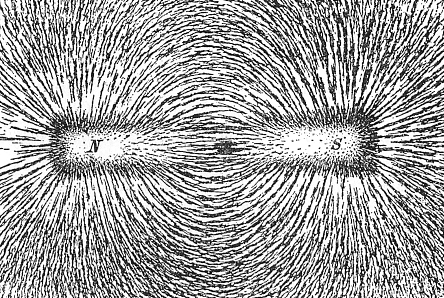|
home | what's new | other sites | contact | about |
|||||||||
|
Word Gems exploring self-realization, sacred personhood, and full humanity
Soulmate, Myself:
Elenchus. The author has posted an inset-box featuring the work of Dr. Iain McGilchrist, especially his new book, The Matter With Things. Kairissi. It’s a massive tome, receiving ultra-superlative praise.
K. You and I have been discussing the mysteries of our favorite subject – authentic romantic love and marriage – for a long time. E. It’s hard for us to come across anything new. K. But we’d like to inform our readers that Dr. McGilchrist’s writings have prompted some new insights. E. Some of it is good confirmation of what we already know. new insights K. But some of it – one or two items – is actually brand new material for us. We’re excited about this, and we look forward to presenting it to our readers. E. It’s what they pay us for. So let’s get into it. K. Why don’t we talk about Jacob’s Ladder first?
E. I like this painting. I like paintings that portray great ideas. K. You’re still threatening to someday produce a series of paintings, a “great ideas gallery.” E. I’d like to share a personal note. This painting has helped me to make more real the fact that everyone’s on a different level of maturity. This principle is not newly hatched for us, but it’s another matter to actually allow it to affect one’s judgment. we’re all just God’s immature kids at different levels of awareness K. It’s easy to fall into the trap of condemnation and unforgiveness, the haughty “why did you do that, I would never have done that.” E. But it suddenly just clicked for me – why should I get angry when somebody acts in a less than perfect manner? We’re all just God’s immature kids on that upward spiral of development, we’re all at different levels of awareness. But, tell us, Kriss - what do you see in Jacob’s Ladder that relates to true love? K. I see the many staircase-spirals as different levels, different purposes, of love and marriage -- ranging from mere animal pleasures to spiritual oneness. E. We had an entire writing featuring these many levels, and we will direct our readers to that discussion. K. And what’s interesting is that, no matter what spiral-level you’re on, you think you’re on the highest level. E. At any spiral-level, you can’t see any higher levels, your vision is blocked.
K. You think you’ve really arrived, it doesn’t get any better than this. I mean, if you’re a newly-wed John-and-Mary, “hotter than a brussel sprout,” well taken by “the fever,” you think you’ve made it now, with fully licensed sex forever, no more wishing and trying to get it. E. And for a very short time, it almost seems true. But then, fairly quickly, it doesn’t feel as great anymore. the calamity of impermanence K. And the same is true for the other purposes of marriage. Let’s say you’ve experienced “rest to the soul” with your beloved, and now you think this peace and tranquility is set in stone. You want to stay on this spiral-level forever. But then the “rest to the soul” flies away like a frightened bird. This calamity of impermanence is true for all spiral-levels in isolation. E. But, here’s what McGilchrist says is the real underlying reason why people fall out of relationship; or think they do. K. We’re about to get into some radical stuff. But – the truth can sound radical when we’re used to error. ‘relationships are more foundational than things related’ E. What could McGilchrist mean by this statement? It doesn’t make sense to us. I mean, I’m here, you’re there, we just met, we have no relationship, but maybe we’d like one. In any case, it seems pretty obvious that the two of us come first in the equation and then, at best, there’s a possibility of relationship.
Rupert Spira: "We tend to imagine the world as composed of separate things – selves and others, minds and bodies, subjects and objects – each existing independently, each coming into contact with others only secondarily. From this perspective, relationship is something that happens between already-existing entities. First there is you, then there is me, and then, perhaps, there is our relationship. But what if the truth was the other way around?"
E. Here is an extended quote adding more detail:
K. There is a lot here. But I think we need to explain some of this. E. A few paragraphs of McGilchrist send us spinning. What would 1600 pages do to our heads? K. Gulp. E. However, if something is true, it will become simpler and simpler the more we go into it. And that’s what I’m finding. K. Elenchus, why don’t you explain what he means by a “re-presentation” of the world. you're so linear E. The concept is something we’ve talked about for years, he just uses new language. The left-brain – which often sounds much like what we call “the dysfunctional ego” – distorts our vision of reality. It sees everything as “things” disconnected and isolated. K. The right-brain is not so unlike our term for the “higher self.” E. When the right-brain becomes more active, it will re-interpret or “re-present” the world as a system of connectedness. K. That’s not so hard to understand. And I think that I’m glimpsing what he means by “relationships are primary.” E. If things in the world are not isolated and disconnected after all, then this would suggest that they’re in various forms of relationship. K. Relationship is the norm if all things are connected. But it’s still hard to wrap my head around the idea that two strangers are already in relationship. strangers in the night E. What do we mean by “strangers”? This is how the left-brain sees the world. Everyone is separate and isolated. K. And I suppose this would mean that all humans are in relationship, but some have a closer bond than others. E. I think that’s the better way of looking at it. K. So, what do we have here? Let’s say more on “relationship is primary.” It seems that we’re speaking of “relationship” as if it were a stand-alone entity in the world with its own existence. Does this take the concept too far? E. Maybe not. We’ll have to proceed very carefully here lest we fall into more confusion. But I think “relationship” can be viewed as a “thing.” K. You’ll have to explain this. E. Recall what Rupert Sheldrake said about morphic fields. K. He said that morphic fields organize energy. the cosmos is a system of organized-energy fields E. They do this in the universe, all the way up the line from atoms to galaxies. K. Morphic fields constitute a “hidden blueprint” for why things are shaped as they are. E. Sheldrake also said that morphic fields affect social interactions of all living things. K. And now we’re back to “relationships.” What does this really mean? E. Morphic fields are primary, are the “hidden blueprints” of the universe, and this is why relationships are primary. I think that morphic fields which govern or manage relationships are fields of energy. K. Organized energy which is directed toward certain ends and purposes. E. Let’s consider, as an analogy, the fields of energy surrounding a magnet.
E. A magnetic field of energy is put together in a certain way. The iron filings are not all over the place but in a certain arrangement. K. They follow the underlying energy. And the iron filings are not primary, the energy field came first. E. I think there’s a morphic energy field directing Twin Souls. K. The Twins are like the iron filings. But the energy field of “relationship” came first. E. Each Twin couple has their own unique morphic-field of relationship. This is why another pretty face can’t enter their energy field. K. It would be like wooden toothpicks trying to be directed by the magnetic field. It won’t work, there's no attraction.
E. There are many side-issues, much could be said, but we will leave this to the meditations of our readers. 'the ever-moving stability' E. Kriss, we must talk about one of McGilchrist’s most counter-intuitive concepts. Initially, I found it very jarring to contemplate, but I now see he’s correct. It’s the “ever-moving stability.” K. Will this become simpler and simpler, as well? 'a stable and changeless form of movement generated eternally' E. Yes, I think so. McGilchrist introduces this idea in the masthead quotations of one of his chapters. Allow me to reprint these statements: It is nonsense to conceive of nature as a static fact, even for an instant devoid of duration. There is no nature apart from transition, and there is no transition apart from temporal duration. Alfred North Whitehead For all bodies are in perpetual flux, like rivers, and parts are constantly entering into and leaving them. Gottfried Wilhelm Leibniz By changing, it remains the same. Heraclitus (Editor: From the endnotes) It is also of interest that the seventh-century theologian Maximus the Confessor wrote: ‘When nature has come to exist in God through the essential unity of him in whom it was created, it will possess an ever-moving stability and a stable and changeless form of movement generated eternally round that which is one, unique and always the same. It has been said that this state is a direct and permanent grounding in the first cause of created beings’ (Maximus, ‘Various texts on theology, the divine economy, and virtue and vice: fifth century’: 1990–2020, vol 2, Part III, §48). K. Elenchus, what is the real significance of this? Why is it important? E. Volumes could be profitably written to answer your question. The significance impinges upon the nature of reality itself, how we develop into mature beings, and the inner-workings of creativity. K. I’d like to hear your thoughts, but I’ll tell you what this reminds me of. In the Gospel Of Thomas article we posted this:
rest and motion K. Would you say that the “rest and motion” of Thomas is related to McGilchrist’s concept? E. Here’s what I see. McGilchrist is speaking out against the left-brain tendency to turn everything into a soulless “thing,” a machine. And when we see people as machines we rob them of their essential humanity. K. And that essential humanity is always changing, in flux, becoming something more. E. The left-brain, like the biologists McGilchrist decries, does not believe in quantum mechanics and its perpetual motion. K. Machines do not grow and develop and so they don’t need the capacity for “eternal motion.” E. The left-brain sees everything as static, lifeless, inert. John is posterboy for left-brain thinking K. And, of course, if “John” is dominated by left-brain thinking, he will devalue the personhood of “Mary.” E. She’s a “thing” to him, just an object of pleasure. K. When McGilchrist quotes the seventh-century theologian, the message seems to be, all things in God are moving and developing, yet there is also an aspect of remaining the same. God’s mind is reflected in the “hidden blueprints” and in Twins’ progression. The mind of God is always and forever at rest in, centered upon, virtue, love, kindness, and the like. This never changes. And yet the godly mind will be constantly growing, expanding innate potential. There’s nothing static about God’s mind or the spiritual growth of Twins: always reaching forward, always delighting in becoming more.
E. We spoke of “the calamity of impermanence.” Can we give the antidote, Kriss? K. It’s a big subject, and I hate to give a quick answer, but, if I must, I’ll say this: Look at the article with all the different purposes of marriage. They’re all good but, focusing on one, if that’s all you have, it won’t last. E. And why won’t it last? Can the pleasures of love and marriage be made permanent? K. Because any one of them is not a true representation of the mind of God. We need the full package. There may be attractions attendant to any of the levels, but they’re lower level attractions – anything is lower level if the mind of God is not truly represented. E. The iron filings live in a “permanence.” K. That’s right. Once a Twin couple accesses a more complete sense of the mind of God, then their underlying morphic field is substantially activated, the energy is much more fully online, and now their attraction for each other is not going away… None of these analogies perfectly describe the process. Words always fall short of the reality. But hopefully we have pointed in the right direction.
“You can’t make the creative act happen. You have to do certain things, otherwise it won’t happen. But it won’t happen while you are doing them.” “What is required is an attentive response to something real and other than ourselves, of which we have only inklings at first, but which comes more and more into being through our response to it – if we are truly responsive to it. We nurture it into being; or not. In this it has something of the structure of love.” - Iain McGilchrist, The Matter With Things: Our Brains, Our Delusions
the structure of love E. McGilchrist seems to be saying that creativity is a close sister to the “structure of love.” But does love have a “structure”? What do you think, Kriss? K. Well, I wouldn’t have thought so, but after our discussion I’m finding some new perspectives. Let me ask this: Does the "love" or attraction of the iron filings to the energy field have a “structure”? Assuredly, it does. E. And how shall we define “love”? K. There are different definitions, but, for Twins, it’s all about that underlying morphic field. Without that, you have no relationship, and there’ll be no love – not the good kind couples want.
'I knew I loved you before I met you'
Savage Garden, “I Knew I Loved You” (1999) I knew I loved you before I met you
K. A most beautiful concept: "I knew I loved you before I met you." There's a certain sense of this which lovers understand. E. But their hearts could never wait expectently if there were not some non-physical substrata to intuitions. K. I believe you are correct. E. We can't make love overwhelm by command, and “you can’t make the creative act happen,” said McGilchrist. And even if you’re Twins, you can’t just put it in your daytimer to feel all lovey-dovey at the appointed hour. K. It is like creativity. We can't be creative on the moment. E. We're required to wait for the muse. K. But the muse delays her coming if we fail to "attend." The best we can do is “attend” to creativity and to the feelings of love; that is, we must remain open in our spirits, keeping ourselves from left-brain hegemony.
|
|||||||||
|
|
